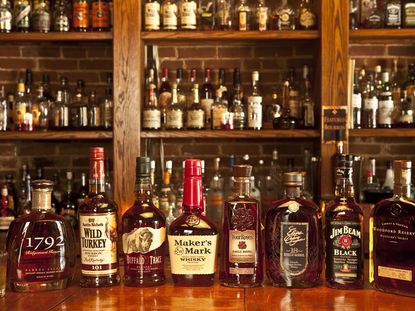On the bourbon trail
Robin Barwick looks at Louisville's bourbon heritage as the second round of the USPGA Championship gets underway in Kentucky


Robin Barwick looks at Louisville's bourbon heritage as the second round of the USPGA Championship gets underway in Kentucky
No less than 95% of the world’s bourbon is produced in Kentucky. In other parts of the United States, a genuine bourbon bar needs to stock around a dozen different bourbons, but in Louisville, Kentucky’s primary city and where the 2014 USPGA Championship is being played this week, a serious bourbon bar stocks at least 50.
Key to Kentucky’s bourbon heritage is its prolific corn productivity. Back in the 18th century, when Kentucky’s first settlers established vast arable farms, there was so much corn surplus that rather than see it go to waste, farmers set about distilling the corn into whisky. Kentucky bourbon was non-perishable, easy to store and easy to sell, so it fast became a staple of the state’s economy.
At the turn of the 19th century, Kentucky boasted a roaring trade of 200 distilleries, but when Prohibition was introduced in 1919, in an attempt to convert the United States into an alcohol-free nation, Kentucky’s bourbon trade was brought to its knees.
“Prohibition was a failed social experiment and it nearly wiped out the entire industry,” starts Stacey Yates, of Louisville Convention and Visitors Bureau. “It lasted 13 years, and during that time only four distilleries in Kentucky kept their licence to distill bourbon, which was for medicinal purposes. You could get a doctor’s prescription to take one tablespoon of bourbon a day, and that is why today in the United States, we still sell alcohol in our pharmacies. Back then you didn’t go to a saloon for bourbon, you went to the drug store.”
What distinguishes bourbon from other whiskies, by the way, is that bourbon must be made from at least 51 percent corn, and it also has to be distilled in previously unused charred-oak barrels.
Today, Louisville is in the midst of a bourbon boom, and visitors can embark on its ‘Urban Bourbon trail’, which maps out over 30 bars that each serve at least 50 bourbons. One such bar, the Down One Bourbon Bar on Louisville’s Main Street, is even set-up like a Prohibition era ‘speak-easy’ bar, where visitors must knock on a door and utter a password for entry.
Get the Golf Monthly Newsletter
Subscribe to the Golf Monthly newsletter to stay up to date with all the latest tour news, equipment news, reviews, head-to-heads and buyer’s guides from our team of experienced experts.
Robin Barwick travelled to the PGA Championship courtesy of Mercedes-Benz. Mercedes-Benz is the official car of the PGA Championship

Nick Bonfield joined Golf Monthly in 2012 after graduating from Exeter University and earning an NCTJ-accredited journalism diploma from News Associates in Wimbledon. He is responsible for managing production of the magazine, sub-editing, writing, commissioning and coordinating all features across print and online. Most of his online work is opinion-based and typically centres around the Majors and significant events in the global golfing calendar. Nick has been an avid golf fan since the age of ten and became obsessed with the professional game after watching Mike Weir and Shaun Micheel win The Masters and PGA Championship respectively in 2003. In his time with Golf Monthly, he's interviewed the likes of Rory McIlroy, Justin Rose, Jose Maria Olazabal, Henrik Stenson, Padraig Harrington, Lee Westwood and Billy Horschel and has ghost-written columns for Westwood, Wayne Riley, Matthew Southgate, Chris Wood and Eddie Pepperell. Nick is a 12-handicap golfer and his favourite courses include Old Head, Sunningdale New, Penha Longha, Valderrama and Bearwood Lakes. If you have a feature pitch for Nick, please email nick.bonfield@futurenet.com with 'Pitch' in the subject line. Nick is currently playing: Driver: TaylorMade M1 Fairway wood: TaylorMade RBZ Stage 2 Hybrid: Ping Crossover Irons (4-9): Nike Vapor Speed Wedges: Cleveland CBX Full Face, 56˚, Titleist Vokey SM4, 60˚ Putter: testing in progress! Ball: TaylorMade TP5x
-
 JM Eagle LA Championship Prize Money Payout 2024
JM Eagle LA Championship Prize Money Payout 2024There’s a record purse for a regular-season LPGA Tour event at Wilshire Country Club
By Mike Hall Published
-
 ‘I Think I Can Be Helpful’ – Rory McIlroy Opens Up On Potential Return To PGA Tour Policy Board
‘I Think I Can Be Helpful’ – Rory McIlroy Opens Up On Potential Return To PGA Tour Policy BoardThe four-time Major winner resigned from the board six months ago, but with the game still fractured, he could be about to return
By Mike Hall Published